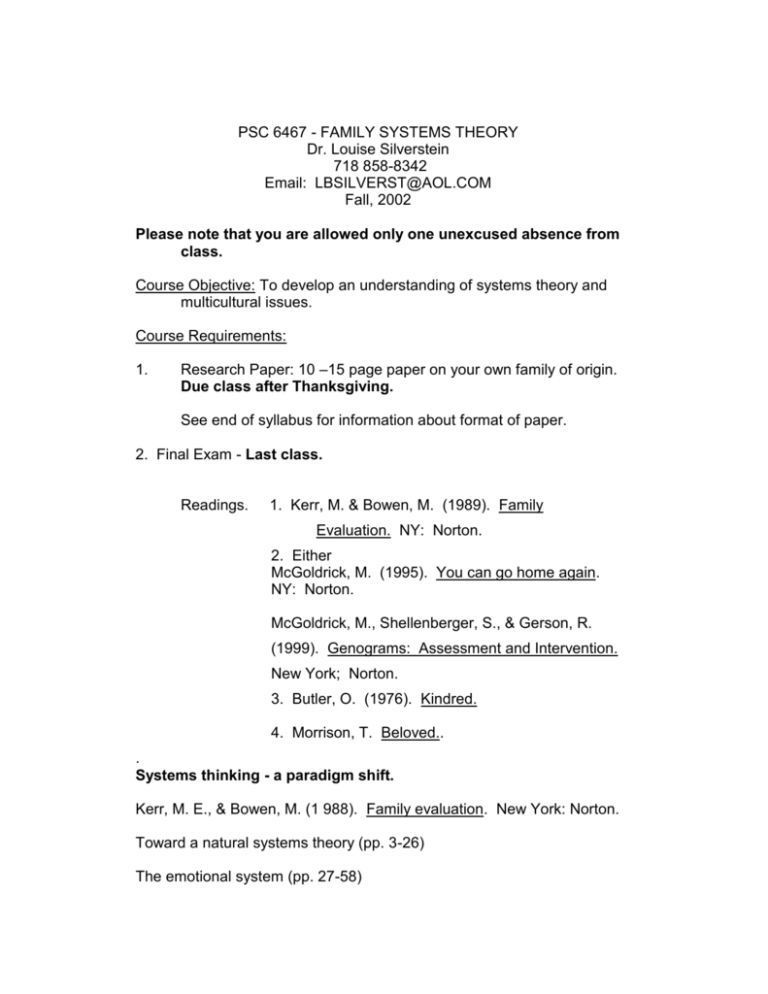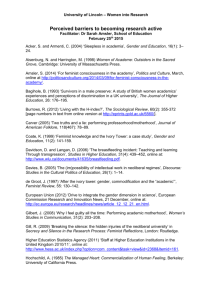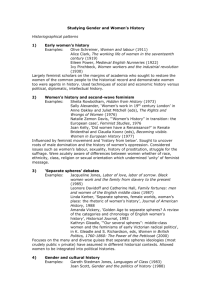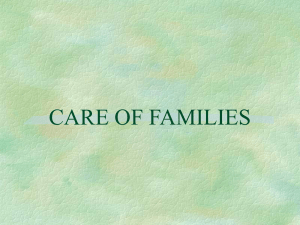Family Systems Theory
advertisement

PSC 6467 - FAMILY SYSTEMS THEORY Dr. Louise Silverstein 718 858-8342 Email: LBSILVERST@AOL.COM Fall, 2002 Please note that you are allowed only one unexcused absence from class. Course Objective: To develop an understanding of systems theory and multicultural issues. Course Requirements: 1. Research Paper: 10 –15 page paper on your own family of origin. Due class after Thanksgiving. See end of syllabus for information about format of paper. 2. Final Exam - Last class. Readings. 1. Kerr, M. & Bowen, M. (1989). Family Evaluation. NY: Norton. 2. Either McGoldrick, M. (1995). You can go home again. NY: Norton. McGoldrick, M., Shellenberger, S., & Gerson, R. (1999). Genograms: Assessment and Intervention. New York; Norton. 3. Butler, O. (1976). Kindred. 4. Morrison, T. Beloved.. . Systems thinking - a paradigm shift. Kerr, M. E., & Bowen, M. (1 988). Family evaluation. New York: Norton. Toward a natural systems theory (pp. 3-26) The emotional system (pp. 27-58) 2 Individuality & Togetherness (pp. 59-88) Triangles (pp. 134-162) Multi-generational emotional process (pp. 221) Differentiation of self (pp. 89-111) B. Working on your own family. McGoldrick, M. (1995). You can go home again, New York: Norton. McGoldrick, M., Shellenberger, S., & Gerson, R. (1999). Genograms: Assessment and Intervention. New York; Norton. Parham, T. A., White, J. L., & Ajamu, A. (1999). The psychology of Blacks. An African Centered Perspective. Third Edition. Upper Saddle River, NJ: Prentice Hall. Kerr, M. E., & Bowen, M. (1988). Family evaluation. New York: Norton. Chapter 10. Pinderhughes, E. (1998). Black genealogy revisited. In M. McGoldrick, M.(Ed.) Re-visioning family therapy (pp. 170-199). NY: Guilford.. C. Examining our cultural biases. The Family Life Cycle. Rice, J. K. (2003). “I can’t go back.” Divorce as adaptive resistance. In L. B. Silverstein & T. J. Goodrich (Editors). Feminist Family Therapy. Empowerment in social context. APA Books. Hernandez. M. & McGoldrick, M. (1999). Migration and the famly life cycle. In B. Carter & M. McGoldrick (Eds.) The expanded family life cycle. Third Edition (pp.169-184). Boston: Allyn & Bacon. 3 English, M. (1996). Transgenerational homophobia in the family. In J. Laird & R. J. Green (Eds). Lesbians and gays in couples and families (pp. 1527). San Francisco: Jossey-Bass. Burton, L. M. (1990). Teenage childbearing as an alternative lifecourse strategy in multigenerational Black families. Human Nature, 1, 123-143. Diversity and Family Therapy. "The first thing you do is to forget that I'm Black. Second, You must never forget that I'm black." from For the White Person Who wants to know how to Be My Friend, by Pat Parker. Marks, J. (1994, December). Black, white, other. Natural History, 3235. Butler, O. (1976). Kindred. Morrison, T. Beloved. McLloyd, V. C., Cauce, A. M., Takeuchi, D., & Wilson, L. (2000). Marital processes and parental socialization in families of color: A decade review of research. Journal of Marriage and the Family, 62, 1070-1093. Hardy, K. V. & Laszloffy, T. A. (1998). The dynamics of a pro-racist ideology. In M. McGoldrick (Ed.), Re-visioning family therapy (pp. 118-128). Dolan-Del Vecchio, K. (1998). Dismantling White male privilege within Family therapy. In M. McGoldrick (Ed.), Re-visioning family therapy (pp. 150-178). Pinderhughes, E. (1986). Minority women: A nodal position in the functioning of the social system. In M. Alt-Riche (Ed.), Women and family therapy (pp. 51-63). Rockville, MD: Appen Systems. 4 Comas-Diaz, L. (1994). LatiNegra: Mental health issues of African Latinas. Journal of Feminist Family Therapy, 5, 35-74. Comas-Diaz, L. (2003). The Black Madonna. In L. B. Silverstein & T. J. Goodrich (Editors). Feminist Family Therapy. Empowerment in social context. APA Books. Friedman, E. H. (1982). The myth of the shiksa. In M. McGoldrick, J. K. Pearce, & J. Giordano, Ethnicity and Family Therapy (pp. 499526). Working with Gay and Lesbian families. Green, R-J,. & Mitchell, V. (2002). Gay and lesbian couples in therapy: Homophobia, relational ambiguity, and social support. In A. S. Gurman & N. S. Jacobson (Eds.), Clinical handbook of Couple Therapy 3rd Edition (pp. 546-568). NY: Guilford. Green, R. J., Bettinger, M., & Zackes, E. (1996). Are Lesbian couples fused and gay male couples disengaged? Questioning gender stereotypes. In J. S. Laird, & R. J. Green (Eds.), Lesbians and gaysin couples and families: A handbook for therapists. San Francisco, CA: Jossey-Bass, Inc. (pp.185-230). Laird, J. (1994). Lesbian families: A cultural perspective. In M. P. Mirkin (Ed.) Women in context. Toward a feminist reconsturction of psychotherapy (pp. 118-148). New York: Guilford Press. Patterson, C. (1995). Lesbian mothers, gay fathers, and their children. In A. R. DAugelli & C. J. Patterson (Eds.) Lesbian, gay, and bisexual identities over the lifespan. Feminist Family Therapy Goodrich, T. J. (2003). What does feminist family therapy have to teach psychologists? In L.B.Silverstein and T. J. Goodrich (Eds.) 5 Feminist family therapy: Empowerment in social context. Washington, DC: APA Books. Garcia-Preto, N. Latinas in the U.S.: Bridging Two Worlds. In M. McGoldrick (Ed.), Re-visioning family therapy (pp. 215-228). Goldner, V. (1991). Sex, power, and gender: A feminist systematic analysis of the politics of passion. Journal of Feminist Family Therapy, a(1/2), 63-83. Brooks, G. (2003). Helping men embrace equality. In L. Silverstein and T. J. Goodrich (Eds.) Feminist family therapy: Empowerment in social context. Washington, DC: APA Books. 6 Guidelines for Family Of Origin Paper 7 I know that this assignment generates anxiety in people. Anxiety is a prerequisite for change. One goal of the cours e is to change the way you understand human behavior. This assignment is directly related to that goal. You can turn in your paper anonymously, using only your student I. D. There are several theoretical reasons for this paper. First, family systems theory is very different from the individually-based, intrapsychic paradigm in which we have all been culturally socialized and professionally trained . In order to understand this new theory, it is not enough to learn it at a cognitive level. We must also learn the concepts experientially, and at a limbic systems level. Working on our own family helps us reach these levels of understanding. Second, family systems theory is a natural systems theory that does not pathologize human behavior. We have all been trained in the medical model that pathologizes human behavior. It is very difficult to give up this pathologizing stance. Understanding the multigenerational transmission process, the individuality/togetherness forces, and the triangles in our own families fills us with humility, and helps us not to pathologize others. Finally, understanding behavior in terms of process rather than content is essential in helping people change. Writing about our own family in terms of process helps us develop this skill. Please limit your paper to 15 pages. Put the paper and your genogram into a large envelope with your name or (I.D.number) on it. Put a header on every page with your name or I. D. number. If you use a geneology program rather than a genogram program, remember that you will have to add birth dates, marriage dates, and draw the triangles by hand. 8 1. Buy the APA Publication Manual 5th Edition and familiarize yourself with APA style. This includes section headings, page numbering, tense, etc. 2. Because every genogram should be a problem-focused genogram, begin the paper with an issue in your life that you feel stuck on. This could be something about relationships, such as anger toward your father, or difficulty choosing a life partner; or it could be an identity issue such as procrastination, being hypercritical, etc. 3. Begin the paper by articulating this issue. 4. Then tell the story of your family. Begin with your great grandparents’ generation if you can. Tell the story of each generation, using the McGoldrick guide in terms of content, and the Kerr and Bowen book in terms of process. As you tell the story, describe triangles, functional sibling position, patterns of closeness and distance, etc. When you have completed the story of one parent, do the same thing for the other parent. 5. At the end of the paper, go back to the life issue that you articulated in the beginning of the paper. You should be able to see it more clearly from a process perspective. End the paper by giving yourself some homework that will help you continue to put your issue into perspective in terms of the multigenerational transmission process and the triangles in which you are embedded. 6. Sections of the paper – use sub-headings. Life Issue Maternal Family Paternal Family Current Family of Origin. Current Family of Choice (if applicable). Conceptualization and Homework. 9 You will be graded on: (everyone gets an A or B.) 1.how much effort you put into interviewing the largest number of family members, and 2. how well you conceptualize the process issues. In order to ensure confidentiality, you can use only your student ID, rather than your name if you prefer.







